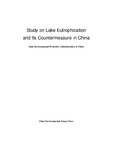| dc.contributor.author | Mavuti, KM | |
| dc.contributor.author | Kitaka, N | |
| dc.contributor.author | Harper, DM | |
| dc.date.accessioned | 2013-06-25T06:27:31Z | |
| dc.date.available | 2013-06-25T06:27:31Z | |
| dc.date.issued | 2001 | |
| dc.identifier.citation | Study on Lake Eutrophication and Its Countermeasure in China State Environmental Protection Administration of China | en |
| dc.identifier.uri | http://61.156.33.41/wwts/X/A2085756.pdf | |
| dc.identifier.uri | http://hdl.handle.net/11295/39359 | |
| dc.description.abstract | Lake Naivasha is the only freshwater (<5000 s/cm) Lake in Kenya’s Rift Valley. The Lake is
continually becoming more eutrophic due to environmental degradation and anthropogenic organic pollution and
nutrient loading from intensive agricultural practices on the Aberdares and Kinangop catchments. Phytoplankton
biomass shows a significant increase with time over the past decade. Some positive correlation between algae
biomass, phosphorus and nitrogen dynamics have been discerned. There is overwhelming evidence of reduced
Phytoplankton species diversity over the years which may be correlated with soluble reactive Phosphorus (PO4
–P)
and soluble nitrates. It is predicted that with the current increase in population and agricultural practices, by the year
2010, the Lakes nutrient levels and eutrophic status will be more than trebled. The possible management solution
would be rational management of agricultural land use. | en |
| dc.language.iso | en | en |
| dc.publisher | China Environmental Science Press | en |
| dc.subject | Nutrient loading | en |
| dc.subject | Eutrophication | en |
| dc.subject | Environmental management | en |
| dc.title | Eutrophication Prognosis and Realities for Lake Naivasha: Causes, Effects and Management Strategies | en |
| dc.type | Book chapter | en |
| local.publisher | Department of Zoology, University of Nairobi | en |
| local.publisher | Department of Zoology, Leicester University, Leicester, England | en |

